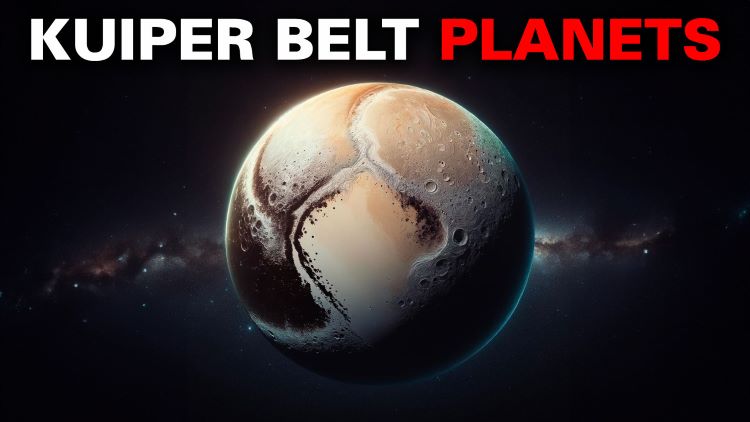A recent study published in The Astrophysical Journal Letters investigates the potential existence of Mars-sized free-floating planets (FFPs)—also known as rogue planets, starless planets, and wandering planets—that could have been captured by our Sun’s gravity long ago and orbit in the outer solar system approximately 1,400 astronomical units (AU) from the Sun. For context, the farthest known planetary body in the solar system is Pluto, which orbits approximately 39 AU from the Sun, and is also part of the Kuiper Belt, which scientists estimate extends as far out as 1,000 AU from the Sun.
Continue reading “How Many Planets Could Be in the Kuiper Belt?”If Planet 9 has Moons, Would That Help Us Find It?

Planet 9 continues to remain elusive. This potential super-Earth-sized object in the outer Solar System is only hypothetical, as something out there appears to be gravitationally influencing several Kuiper Belt Objects into unusual orbits. Whatever or wherever it may be, Planet 9 has yet to be found, despite several different hypotheses and numerous observational searches.
But what if Planet 9 has moons? Could they help us find it? A new paper speculates that any moons orbiting the theoretical planet could provide indirect clues to the location of Planet 9, while revealing some basic properties of this mysterious object.
Continue reading “If Planet 9 has Moons, Would That Help Us Find It?”Not Saying it was Aliens, but ‘Oumuamua Probably Wasn’t a Nitrogen Iceberg…
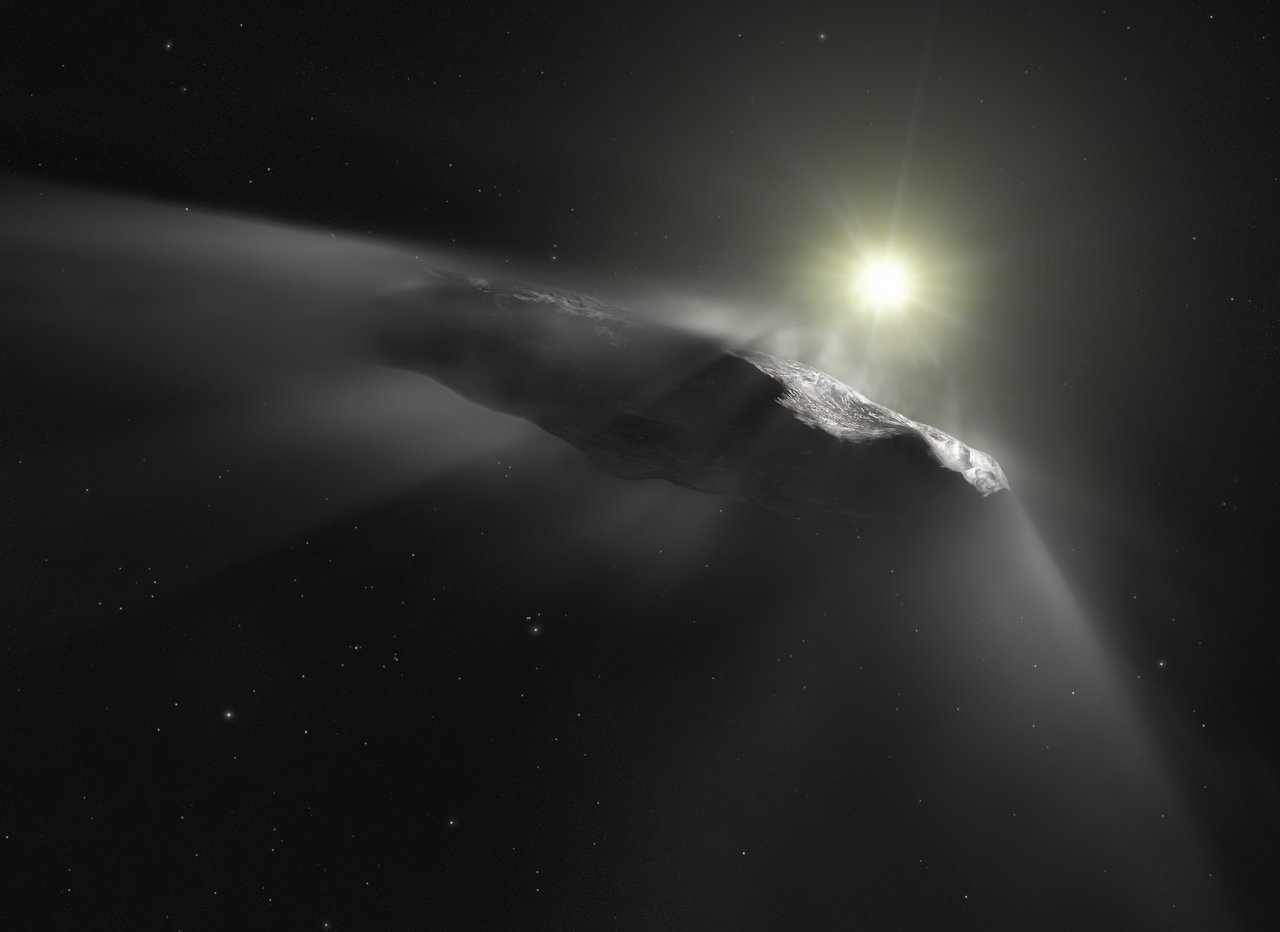
On October 19th, 2017, astronomers made the first-ever detection of an interstellar object (ISO) passing through our Solar System. Designated 1I/2017 U1′ Oumuamua, this object confounded astronomers who could not determine if it was an interstellar comet or an asteroid. After four years and many theories (including the controversial “ET solar sail” hypothesis), the astronomical community appeared to land on an explanation that satisfied all the observations.
The “nitrogen iceberg” theory stated that ‘Oumuamua was likely debris from a Pluto-like planet in another solar system. In their latest study, titled “The Mass Budget Necessary to Explain ‘Oumuamua as a Nitrogen Iceberg,” Amir Siraj and Prof. Avi Loeb (who proposed the ET solar sail hypothesis) offered an official counter-argument to this theory. According to their new paper, there is an extreme shortage of exo-Plutos in the galaxy to explain the detection of a nitrogen iceberg.
Continue reading “Not Saying it was Aliens, but ‘Oumuamua Probably Wasn’t a Nitrogen Iceberg…”Nancy Grace Roman Telescope is Getting an Upgraded new Infrared Filter
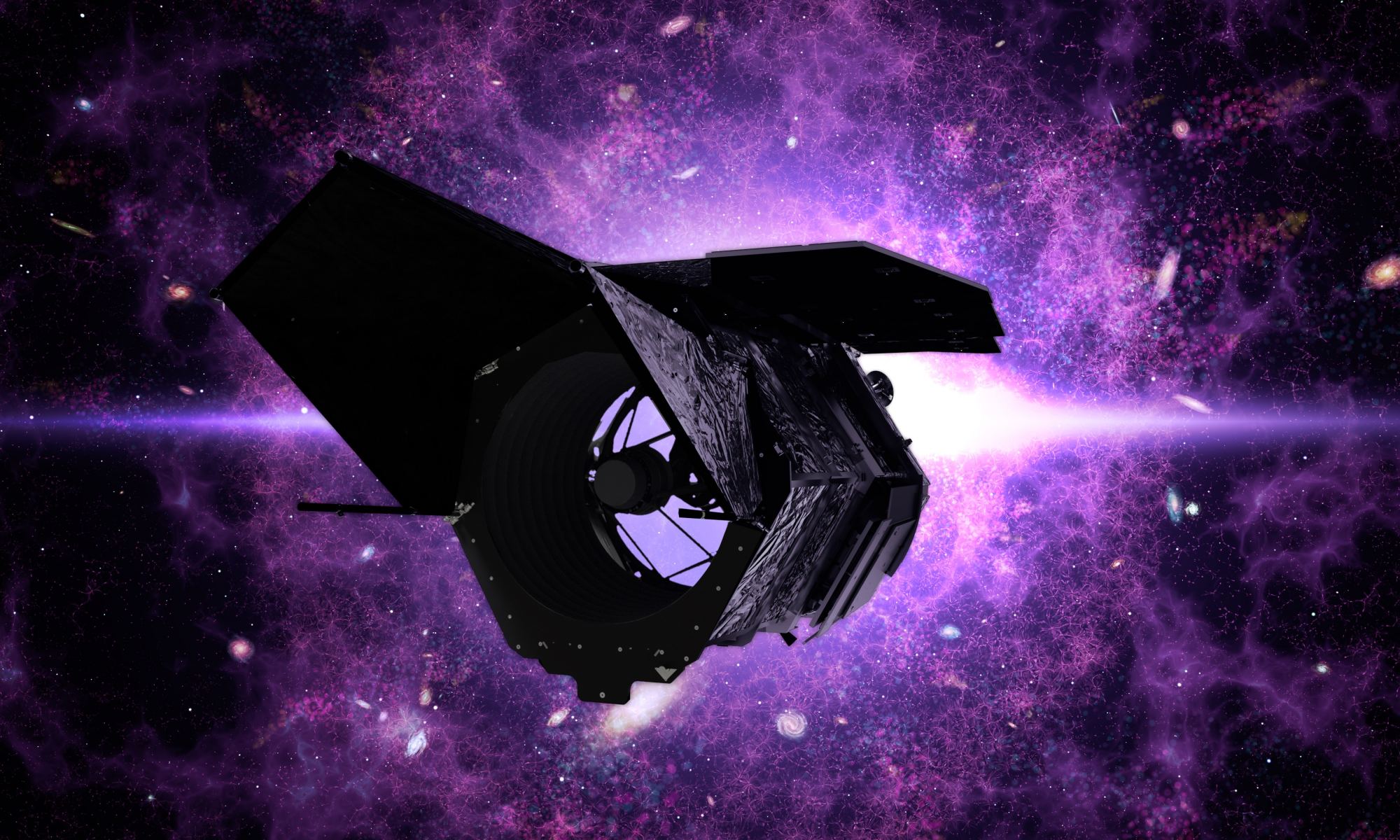
In 2025, the Nancy Grace Roman space telescope will launch to space. Named in honor of NASA’s first chief astronomer (and the “Mother of Hubble“), the Roman telescope will be the most advanced and powerful observatory ever deployed. With a camera as sensitive as its predecessors, and next-generation surveying capabilities, Roman will have the power of “One-Hundred Hubbles.”
In order to meet its scientific objectives and explore some of the greatest mysteries of the cosmos, Roman will be fitted with a number of infrared filters. But with the decision to add a new near-infrared filter, Roman will exceed its original design and be able to explore 20% of the infrared Universe. This opens the door for exciting new research and discoveries, from the edge of the Solar System to the farthest reaches of space.
Continue reading “Nancy Grace Roman Telescope is Getting an Upgraded new Infrared Filter”The Pictures are Here! New Horizons Close Up View of 2014 MU69
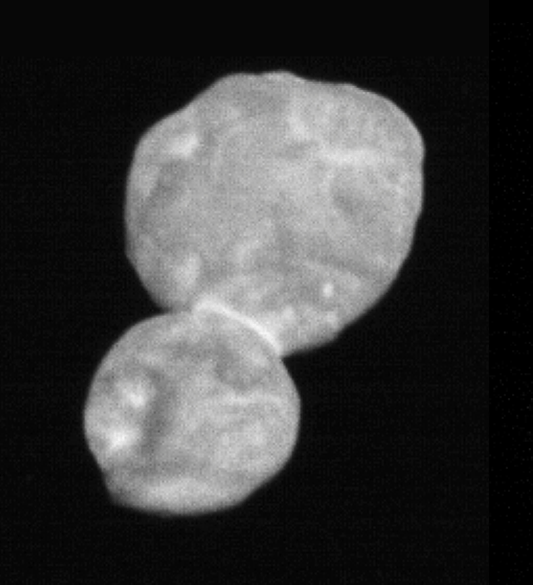
On December 31st, 2018, NASA and the New Horizon‘s team (plus millions of people watching the live stream at home) rang in the New Year by watching the New Horizons mission make the first rendezvous in history with a Kuiper Belt Object (KBO). About thirty minutes after the probe conducted its flyby of Arrokoth (2014 MU69), the mission controllers were treated to the first clear images ever taken of a KBO.
Since the first approach photographs were released (which were pixilated and blurry), the New Horizons team has released new images from the spacecraft that show Ultimate Thule in color and greater detail. It’s appearance, which resembles that of a snowman, beautifully illustrates the kinds of processes that created our Solar System roughly four and a half billion years ago.
Continue reading “The Pictures are Here! New Horizons Close Up View of 2014 MU69”It Might Not be Planet 9 Causing Disruptions in the Kuiper Belt, Just the Collective Gravity of Everything Out There

In January of 2016, astronomers Mike Brown and Konstantin Batygin published the first evidence that there might be another planet in our Solar System. Known as “Planet 9” (or “Planet X”, to those who contest the controversial 2006 Resolution by the IAU), this hypothetical body was believed to orbit at an extreme distance from our Sun, as evidenced by the fact that certain Trans-Neptunian Objects (TNOs) all seem to be pointing in the same direction.
Since that time, other lines of evidence have emerged that have bolstered the existence of Planet 9/Planet X. However, a team of researchers from CU Boulder recently proposed an alternative explanation. According to their research, it could be interactions between Kuiper Belt Objects (KBOs) themselves that might explain the strange dynamics of “detached objects” at the edge of the Solar System.
The researchers presented their findings at the 232nd meeting of the American Astronomical Society, which ran from June 3-7 in Denver, Colorado. The presentation took place on June 4th during a press conference titled “Minor Planets, Dwarf Planets & Exoplanets”. The research was led Jacob Fleisig, an undergraduate studying astrophysics at CU Boulder, and included Ann-Marie Madigan and Alexander Zderic – an assistant professor and a graduate student at CU Boulder, respectively.
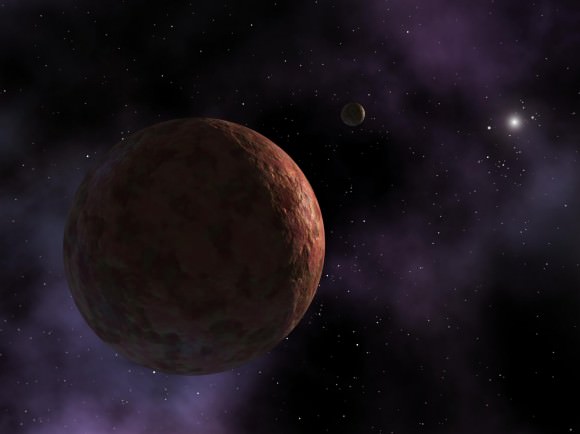
For the sake of their study, the team focused on icy bodies like Sedna, a minor planet that orbits the Sun at a distance ranging from 76 AU at perihelion to 936 AU at aphelion. Along with a handful of other objects at this distance, such as Eris, Sedna appears to be separated from the rest of the Solar System – something which astronomers have struggled to explain ever since it was discovered.
Sedna was also discovered by Michael Brown who, along with Chad Trujillo of the Gemini Observatory and David Rabinowitz of Yale University, spotted it on November 14th, 2003, while conducting a survey of the Kuiper Belt. In addition to orbiting our Sun with a period of over 11,000 years, this minor planet and other detached objects has a huge, elliptical orbit.
What’s more, this orbit does not take them Sedna or these other objects anywhere near to Neptune or any other gas giant. Unlike Pluto and other Trans-Neptunian Objects (TNOs), it is therefore a mystery how they achieved their current orbits. The possible existence of a as-yet-undiscovered planet (Planet 9/Planet X), which would be about 10 times the size of Earth, is one hypothetical explanation.
After years of searching for this planet and attempting to determine where its orbit would take it, astronomers have yet to find Planet 9/Planet X. However, as Prof. Madigan explained in a recent CU Boulder press release, there is another possible explanation for the gravitational weirdness going on out there:
“There are so many of these bodies out there. What does their collective gravity do? We can solve a lot of these problems by just taking into account that question… Once you get further away from Neptune, things don’t make any sense, which is really exciting.”
While Madigan and her team did not originally set out to find another explanation for the orbits of “detached objects”, they ended up pursuing the possibility thanks to Jacob Fleisig’s computer modelling. While developing simulations to explore the dynamics of the detached objects, he noticed something very interesting about the region of space they occupy.
Having calculated the orbits of icy objects beyond Neptune, Fleisig and the rest of the team noticed that different objects behave much like the different hands on a clock. Whereas asteroids move like the minute hand (relatively fast and in tandem), larger objects like Sedna move more slowly like the hour hand. Eventually, the hands intersect. As Fleisig explained:
“You see a pileup of the orbits of smaller objects to one side of the sun. These orbits crash into the bigger body, and what happens is those interactions will change its orbit from an oval shape to a more circular shape.”
What Fleisig’s computer model showed was that Sedna’s orbit goes from normal to detached as a result of those small-scale interactions. It also showed that the larger the detached object, the farther it gets away from the Sun – something which agrees with previous research and observations. In addition to explaining why Sedna and similar bodies behave the way they do, these findings may provide clues to another major event in Earth’s history.
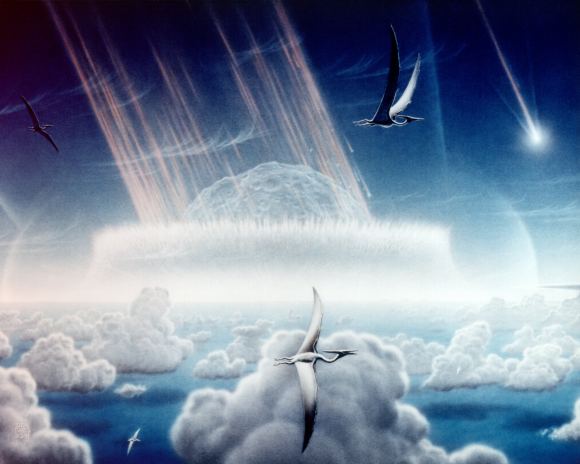
This would be what caused the extinction of the dinosaurs. Astronomers have understood for a long time that the dynamics of the outer Solar System often end up sending comets towards the inner Solar System on a predictable timescale. This is the result of icy objects interacting with each other, which causes their orbits to tighten and widen in a repeating cycle.
And while the team is not able to say that this pattern was responsible for the impact that caused the Cretaceous–Paleogene extinction event (which resulted in the extinction of the dinosaurs 66 million years ago), it is a fascinating possibility. In the meantime, the research has shown just how fascinating the outer Solar System is, and how much remains to be learned about it.
“The picture we draw of the outer solar system in textbooks may have to change,” said Madigan. “There’s a lot more stuff out there than we once thought, which is really cool.”
The research was made possible thanks to the support of the NASA Solar System Workings and the Rocky Mountain Advanced Computing Consortium Summit Supercomputer.
Further Reading: University of Colorado Boulder
What are the Chances that the Next Generation LSST Could Find New Planets in the Solar System?

In the past few decades, thanks to improvements in ground-based and space-based observatories, astronomers have discovered thousands of planets orbiting neighboring and distant stars (aka. extrasolar planets). Strangely enough, it is these same improvements, and during the same time period, that enabled the discovery of more astronomical bodies within the Solar System.
These include the “minor planets” of Eris, Sedna, Haumea, Makemake, and others, but also the hypothesized planetary-mass objects collectively known as Planet 9 (or Planet X). In a new study led by Northern Arizona University and the Lowell Observatory, a team of researchers hypothesize that the Large Synoptic Survey Telescope (LSST) – a next-generation telescope that will go online in 2022 – has a good chance of finding this mysterious planet.
Their study, titled “On the detectability of Planet X with LSST“, recently appeared online. The study was led by David E. Trilling, an astrophysicist from the Northern Arizona University and the Lowell Observatory, and included Eric C. Bellm from the University of Washington and Renu Malhotra of the Lunar and Planetary Laboratory at The University of Arizona.
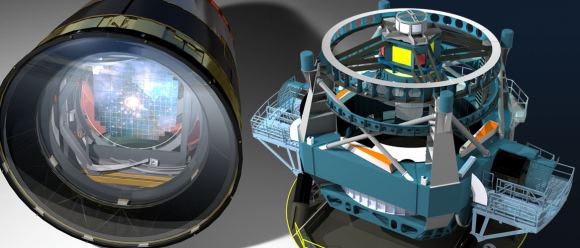
Located on the Cerro Pachón ridge in north-central Chile, the 8.4-meter LSST will conduct a 10-year survey of the sky that will deliver 200 petabytes worth of images and data that will address some of the most pressing questions about the structure and evolution of the Universe and the objects in it. In addition to surveying the early Universe in order to understand the nature of dark matter and dark energy, it will also conduct surveys of the remote areas of the Solar System.
Planet 9/X is one such object. In recent years, the existence of two planetary-mass bodies have been hypothesized to explain the orbital distribution of distant Kuiper Belt Objects. While neither planet is thought to be exceptionally faint, the sky locations of these planets are poorly constrained – making them difficult to pinpoint. As such, a wide area survey is needed to detect these possible planets.
In 2022, the LSST will carry out an unbiased, large and deep survey of the southern sky, which makes it an important tool when it comes to the search of these hypothesized planets. As they state in their study:
“The possibility of undiscovered planets in the solar system has long fascinated astronomers and the public alike. Recent studies of the orbital properties of very distant Kuiper belt objects (KBOs) have identified several anomalies that may be due to the gravitational influence of one or more undiscovered planetary mass objects orbiting the Sun at distances comparable to the distant KBOs.
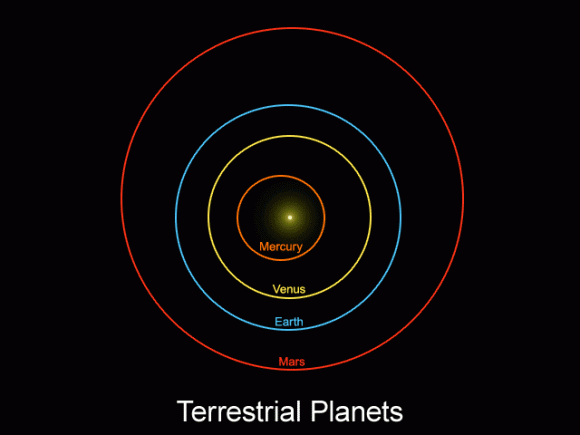
These studies include Trujillo & Sheppard’s 2014 study where they noticed similarities in the orbits of distant Trans-Neptunian Objects (TNOs) and postulated that a massive object was likely influencing them. This was followed by a 2016 study by Sheppard & Trujillo where they suggested that the high perihelion objects Sedna and 2012 VP113 were being influence by an unknown massive planet.
This was followed in 2016 by Konstantin Batygin and Michael E. Brown of Caltech suggesting that an undiscovered planet was the culprit. Finally, Malhotra et al. (2016) noted that the most distant KBOs have near-integer period ratios, which was suggestive of a dynamical resonance with a massive object in the outer Solar System. Between these studies, various mass and distance estimates were formed that became the basis of the search for this planet.
Overall, these estimates indicated that Planet 9/X was a super-Earth with anywhere between 5 to 20 Earth masses, and orbited the Sun at a distance of between 150 – 600 AU. Concurrently, these studies have also attempted to narrow down where this Super-Earth’s orbit will take it throughout the outer Solar System, as evidenced by the perturbations it has on KBOs.
Unfortunately, the predicted locations and brightness of the object are not yet sufficiently constrained for astronomers to simply look in the right place at the right time and pick it out. In this respect, a large area sky survey must be carried out using moderately large telescopes with a very wide field of view. As Dr. Trilling told Universe Today via email:
“The predicted Planet X candidates are not particularly faint, but the possible locations on the sky are not very well constrained at all. Therefore, what you really need to find Planet X is a medium-depth telescope that covers a huge amount of sky. This is exactly LSST. LSST’s sensitivity will be sufficient to find Planet X in almost all its (their) predicted configurations, and LSST will cover around half of the known sky to this depth. Furthermore, the cadence is well-matched to finding moving objects, and the data processing systems are very advanced. If you were going to design a tool to find Planet X, LSST is what you would design.”
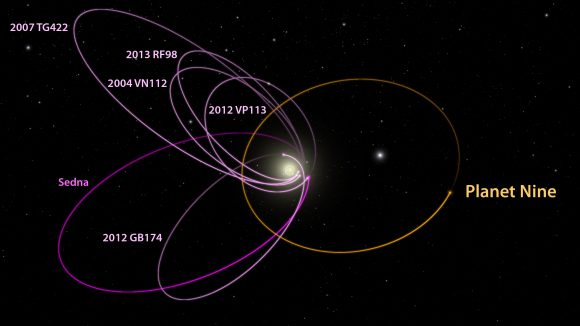
However, the team also acknowledges that within certain parameters, Planet 9/X may not be detectable by the LSST. For example, it is possible that that there is a very narrow slice of predicted Planet 9/X parameters where it might be slightly too faint to be easily detected in LSST data. In addition, there is also a small possibility that irregularities in the Planet 9/X cadence might lead to it being missed.
“The more likely conclusion if planet X is not detected in LSST data is that planet X doesn’t exist – or at least not the kind of planet X that has been predicted. In this case, we’ve got to work harder to understand how the Universe created this pattern of orbits in the outer Solar System that I described above. This is a really fun part of science: make a prediction and test it, and find that the result is rarely what is predicted. So now we’ve got to work harder to understand the universe. Hopefully this new understanding makes new predictions that we then can test, and we repeat the cycle.”
Further Reading: arXiv
New Clues Emerge for the Existence of Planet 9

Planet 9 cannot hide forever, and new research has narrowed the range of possible locations further! In January of 2016, astronomers Mike Brown and Konstantin Batygin published the first evidence that there might be another planet in our Solar System. Known as “Planet 9” (“Planet X” to some), this hypothetical body was believed to orbit at an extreme distance from our Sun, as evidenced by the orbits of certain extreme Kuiper Belt Objects (eKBOs).
Since that time, multiple studied have been produced that have attempted to place constraints on Planet 9’s location. The latest study once again comes from Brown and Batygin, who conducted an analytical assessment of all the processes that have indicated the presence of Planet 9 so far. Taken together, these indications show that the existence of this body is not only likely, but also essential to the Solar System as we know it.
The study, titled “Dynamical Evolution Induced by Planet Nine“, recently appeared online and has been accepted for publication in The Astronomical Journal. Whereas previous studies have pointed to the behavior of various populations of KBOs as proof of Planet 9, Brown and Batygin sought to provide a coherent theoretical description of the dynamical mechanisms responsible for these effects.
In the end, they concluded that it would be more difficult to imagine a Solar System without a Planet 9 than with one. As Konstantin Batygin explained in a recent NASA press statement:
“There are now five different lines of observational evidence pointing to the existence of Planet Nine. If you were to remove this explanation and imagine Planet Nine does not exist, then you generate more problems than you solve. All of a sudden, you have five different puzzles, and you must come up with five different theories to explain them.”
In 2016, Brown and Batygin described the first three lines of observational evidence for Planet 9. These include six extreme Kuiper Belt Objects which follow highly elliptical paths around the Sun, which are indicative of an unseen mechanism affecting their orbit. Second is the fact that the orbits of these bodies are all tilted the same way – about 30° “downward” to the plane of the Kuiper Belt.
The third hint came in the form of computer simulations that included Planet 9 as part of the Solar System. Based to these simulations, it was apparent that more objects should be tilted with respect to the Solar plane, on the order of about 90 degrees. Thanks to their research, Brown and Batygin found five such objects that happened to fit this orbital pattern, and suspected that more existed.
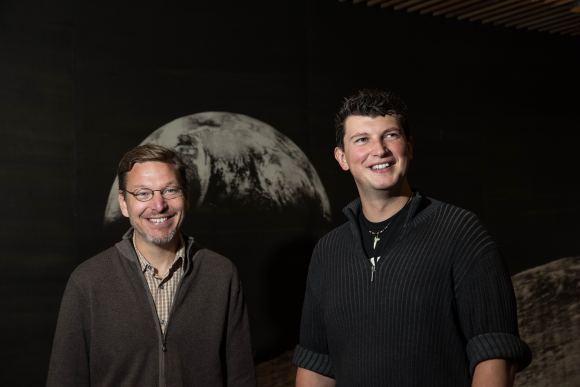
Since the publication of the original paper, two more indications have emerged for the existence of Planet 9. Another involved the unexplained orbits of more Kuiper Belt Objects which were found to be orbiting in the opposite direction from everything else in the Solar System. This was a telltale indication that a relatively close body with a powerful gravitational force was affecting their orbits.
And then there was the argument presented in a second paper by the team – which was led by Elizabeth Bailey, Batygin’s graduate student. This study argued that Planet 9 was responsible for tilting the orbits of the Solar planets over the past 4.5 billion years. This not only provided additional evidence for Planet 9, but also answered a long standing mystery in astrophysics – why the planets are tilted 6 degrees relative to the Sun’s equator.
As Batygin indicated, all of this adds up to a solid case for the existence of a yet-to-discovered massive planet in the outer Solar System:
“No other model can explain the weirdness of these high-inclination orbits. It turns out that Planet Nine provides a natural avenue for their generation. These things have been twisted out of the solar system plane with help from Planet Nine and then scattered inward by Neptune.”
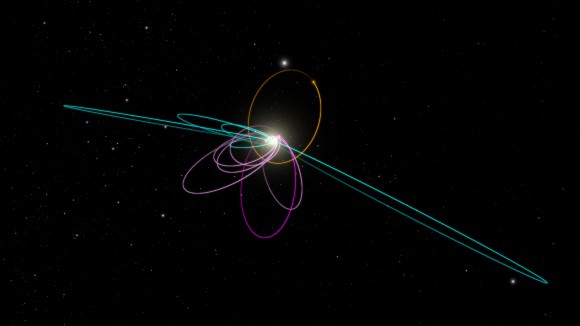
Recent studies have also shed some light on how and where Planet 9 originated. Whereas some suggested that the planet moved to the edge of the Solar System after forming closer to the Sun, others have suggested that it might be an exoplanet that was captured early in the Solar System’s history. At present, the favored theory appears to be that it formed closer to the Sun and migrated outward over time.
Granted, there is not yet a scientific consensus when it comes to Planet 9 and other astronomers have offered other possible explanations for the evidence cited by Batygin and Brown. For instance, a recent analysis based on the Outer Solar System Origins Survey – which discovered more than 800 new Trans-Neptunian Objects (TNOs) – suggests that the evidence could also be consistent with a random distribution of such objects.
In the meantime, all that remains is to find direct evidence of the planet. At present, Batygin and Brown are attempting to do just that, using the Subaru Telescope at the Mauna Kea Observatory in Hawaii. The detection of this planet will not only settle the matter of whether or not it even exists, it will also help resolve a mystery that emerged in recent years thanks to the discovery of thousands of extra-solar planets.
In short, thanks to the discovery of 3,529 confirmed exoplanets in 2,633 solar systems, astronomers have noticed that statistically, the most likely types of planets are “Super-Earths” and “mini-Neptunes” – i.e. planets that are more massive than Earth but not more than about 10 Earth masses. If Planet 9 is confirmed to exist, which is estimated to have 10 times the Mass of Earth, then it could explain this discrepancy.
Planet 9, we know you’re out there and we will find you! Unless you’re not, in which case, disregard this message!
Further Reads: NASA
What Caused the Kuiper Belt to Get Warped?
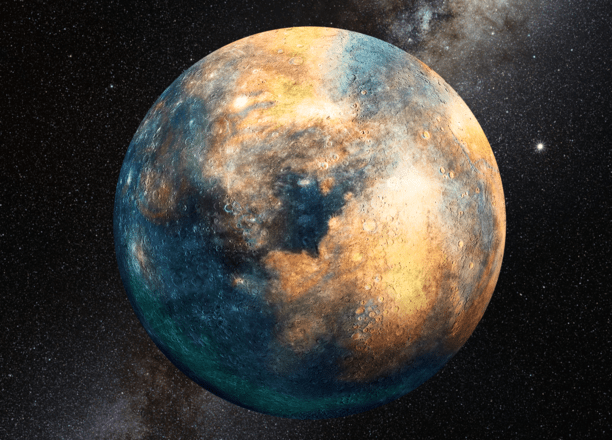
Astronomers have known about the Kuiper Belt for decades, and were postulating about its existence long before it was even observed. Since that time, many discoveries have been made in this region of space – ranging from numerous minor planets to the fact that the orbital planes of Kuiper Belt Objects (KBOs) are widely dispersed – that have led to new theoretical models of the formation and evolution of the Solar System.
For instance, while conducting measurements of the mean plane of minor planets and KBOs, a team from the Lunar and Planetary Laboratory (LPL) at The University of Arizona discovered a warp in orbits of certain, highly-distant KBOs. According to their study, this warp could be an indication of a planetary-mass object in the area, one which orbits our Sun even closer than the theoretical “Planet 9“.
The study – “The Curiously Warped Mean Plane of the Kuiper Belt” which is scheduled to be published in the Astronomical Journal – was produced by Kathryn Volk and Renu Malhotra (two astronomers with the LPL). As they stated in their study, the presence of this planet was confirmed by examining the orbits of icy bodies in the very outer reaches of the Solar System.
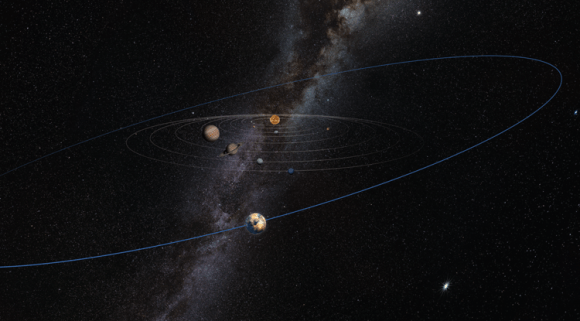
Whereas most KBOs – which are leftover material from the formation of the Solar System – orbit the Sun close to the mean plane of the Solar System itself, the most distant objects do not. To determine why, the researchers analyzed the tilt angles of the orbital planes of more than 600 KBOs to determine the direction of their precession – i.e. the direction in which these rotating objects experience a change in their orientation.
As Malhotra – a Louise Foucar Marshall Science Research Professor and Regents’ Professor of Planetary Sciences at LPL – illustrated, KBOs operate in a way that is analogous to spinning tops:
“Imagine you have lots and lots of fast-spinning tops, and you give each one a slight nudge. If you then take a snapshot of them, you will find that their spin axes will be at different orientations, but on average, they will be pointing to the local gravitational field of Earth… We expect each of the KBOs’ orbital tilt angle to be at a different orientation, but on average, they will be pointing perpendicular to the plane determined by the Sun and the big planets.”
What they found was that the average plane of these objects was tilted away from the solar plane by about eight degrees, which suggests that a powerful gravitational force in the outer Solar System is tugging on them. “The most likely explanation for our results is that there is some unseen mass,” said Volk in UA News press release. “According to our calculations, something as massive as Mars would be needed to cause the warp that we measured.”
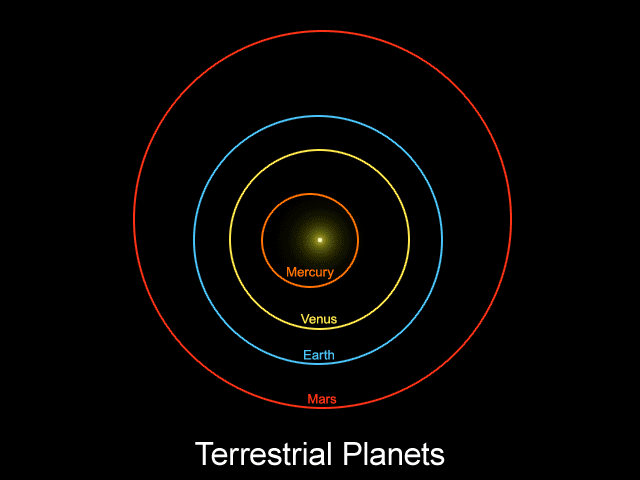
According to their calculations, this Mars-size body would likely orbit the Sun at a distance of roughly 60 AU, and with an orbital inclination that was tilted eight degrees to the average plane of the known planets (i.e. the same tilt as the “warped” KBOs). Within these parameters, a planet of this size would have sufficient gravitational influence to warp the orbital plane of the distant KBOs to within 10 AU on either side of it.
In other words, a Mars-sized planet in the outer Kuiper Belt would be able to influence the orbital inclination of KBOs that are between 50 and 70 AUs from the Sun. This is certainly consistent with what we know about the Kuiper Belt, who’s orbital inclination appears to be consistently flat (i.e. consistent with the rest of the Solar System) past a distance of about 50 AU – but changes between a distance of 50 and 80 AU.
As Volk indicated, there is a possibility that this warping could be the result of a statistical fluke. But in the end, their calculations indicated that this is highly unlikely, and that the behavior of distant KBOs is consistent with the existence of a as-yet-unseen gravitational influence:
“But going further out from 50 to 80 AU, we found that the average plane actually warps away from the invariable plane. There is a range of uncertainties for the measured warp, but there is not more than 1 or 2 percent chance that this warp is merely a statistical fluke of the limited observational sample of KBOs… The observed distant KBOs are concentrated in a ring about 30 AU wide and would feel the gravity of such a planetary mass object over time, so hypothesizing one planetary mass to cause the observed warp is not unreasonable across that distance.”
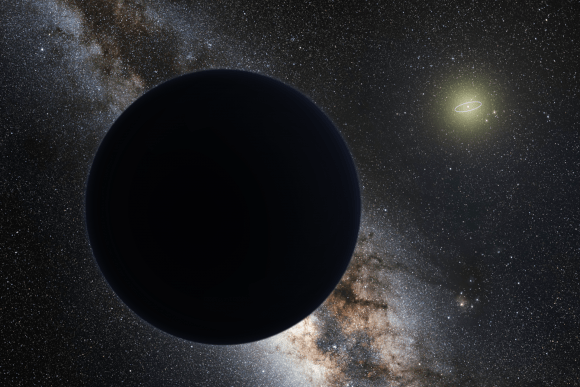
Another possibility is that another object entirely could have disturbed the plane of the outer Kuiper Belt – for instance, a star passing through the outer Solar System. But as Malhotra explained, this explanation is also a highly unlikely, as any disturbance caused by a passing star would only be temporary and would have manifested itself differently.
“A passing star would draw all the ‘spinning tops’ in one direction,” he said. “Once the star is gone, all the KBOs will go back to precessing around their previous plane. That would have required an extremely close passage at about 100 AU, and the warp would be erased within 10 million years, so we don’t consider this a likely scenario.”
Moreover, the tilt of these objects could not be attributed to the existence of Planet 9, who’s existence has also been suggested based on the extreme eccentricity of certain populations of KBOs. Compared to this Mars-sized planet that is thought to orbit at 60 AUs from the Sun, Planet 9 is predicted to be much more massive (at around 10 Earth masses) and is believed to orbit at a distance of 500 to 700 AU.
Naturally, one has to ask why this planetary-mass body has not been found yet. According to Volk and Malhotra, the reason has to do with the fact that astronomers have not yet searched the entire sky for distant for Solar System objects. Beyond that, there’s also the likely position of the object (within the galactic plane), which is so densely packed with stars that surveys would have a hard time spotting it.
However, with the construction of instruments like the Large Synoptic Survey Telescope (LSST) in Chile nearly complete, opportunities to spot it may be coming sooner other than later. This wide-field survey reflecting telescope, which is run by a consortium that includes the University of Arizona, is expected to provide some of the deepest and widest views of the Universe to date (which will begin in 2020).
In the meantime, and in response to any possible controversies regarding the so-called “Planet Debate”, it is worth noting that this body (if it exists) is currently being referred to as “planetary-mass object”. This is because, by definition, a body needs to have cleared its orbit in order to be called a planet. What’s more, the study does not rule out the possibility that the warp could be the result of more than one planetary mass object in the area.
Therefore, it would premature to state that astronomers – having not yet even confirmed the existence of Planet 9 – are now talking about the existence of a possible “Planet 10”. In the coming years, more news and information will become available, which will hopefully help us put the debate to rest and agree on just how many planets there are out there!
Further Reading: UA News, Earth and Planetary Astrophysics
Here’s the Highest Resolution Map of Pluto We’ll Get from New Horizons
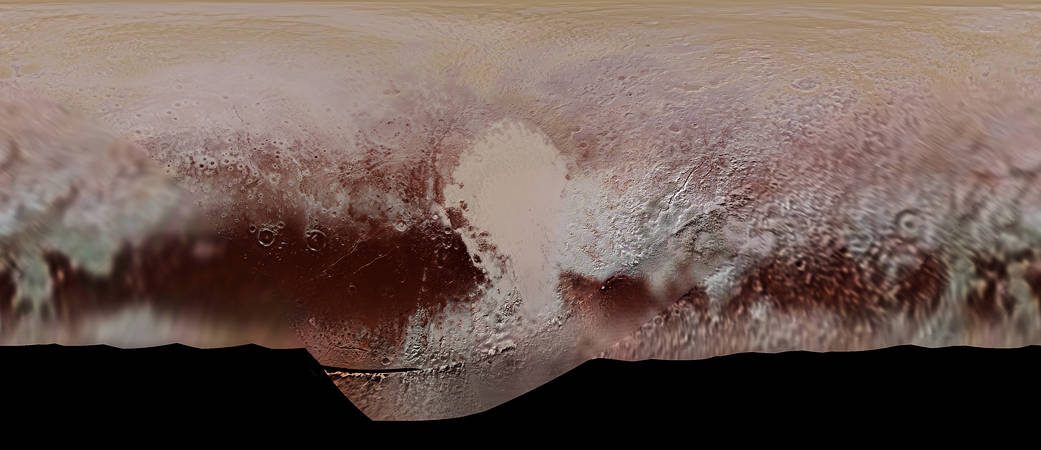
On July 14th, 2015, the New Horizons mission made history by conducting the first flyby of Pluto. This represented the culmination of a nine year journey, which began on January 19th, 2006 – when the spacecraft was launched from the Cape Canaveral Air Force Station. And before the mission is complete, NASA hopes to send the spacecraft to investigate objects in the Kuiper Belt as well.
To mark the 11th anniversary of the spacecraft’s launch, members of the New Horizons team took part in panel a discussion hosted by the Johns Hopkins University Applied Physics Laboratory (JHUAPL) located in Laurel, Maryland. The event was broadcasted on Facebook Live, and consisted of team members speaking about the highlights of the mission and what lies ahead for the NASA spacecraft.
The live panel discussion took place on Thursday, Sept. 19th at 4 p.m. EST, and included Jim Green and Alan Stern – the director the Planetary Science Division at NASA and the principle investigator (PI) of the New Horizons mission, respectively. Also in attendance was Glen Fountain and Helene Winters, New Horizons‘ project managers; and Kelsi Singer, the New Horizons co-investigator.
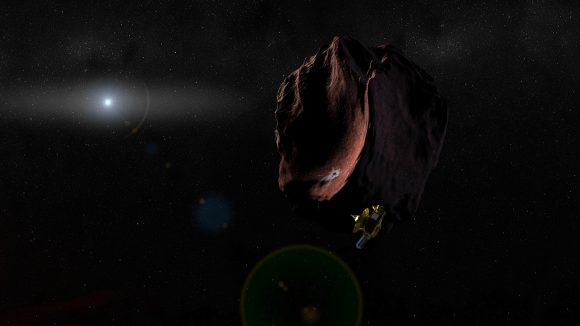
In the course of the event, the panel members responded to questions and shared stories about the mission’s greatest accomplishments. Among them were the many, many high-resolution photographs taken by the spacecraft’s Ralph and Long Range Reconnaissance Imager (LORRI) cameras. In addition to providing detailing images of Pluto’s surface features, they also allowed for the creation of the very first detailed map of Pluto.
Though Pluto is not officially designated as a planet anymore – ever since the XXVIth General Assembly of the International Astronomical Union, where Pluto was designated as a “dwarf planet” – many members of the team still consider it to be the ninth planet of the Solar System. Because of this, New Horizons‘ historic flyby was of particular significance.
As Principle Investigator Alan Stern – from the Southwestern Research Institute (SwRI) – explained in an interview with Inverse, the first phase of humanity’s investigation of the Solar System is now complete. “What we did was we provided the capstone to the initial exploration of the planets,” he said. “All nine have been explored with New Horizons finishing that task.”
Other significant discoveries made by the New Horizons mission include Pluto’s famous heart-shaped terrain – aka. Sputnik Planum. This region turned out to be a young, icy plain that contains water ice flows adrift on a “sea” of frozen nitrogen. And then there was the discovery of the large mountain and possible cryovolcano located at the tip of the plain – named Tombaugh Regio, (in honor of Pluto’s discovered, Clyde Tombaugh).
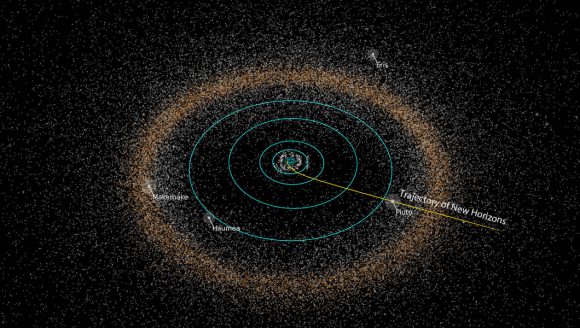
The mission also revealed further evidence of geological activity and cryovolcanism, the presence of hyrdocarbon clouds on Pluto, and conducted the very first measurements of how Pluto interacts with solar wind. All told, over 50 gigabits of data were collected by New Horizons during its encounter and flyby with Pluto. And the detailed map which resulted from it did a good job of capturing all this complexity and diversity. As Stern explained:
“That really blew away our expectations. We did not think that a planet the size of North America could be as complex as Mars or even Earth. It’s just tons of eye candy. This color map is the highest resolution we will see until another spacecraft goes back to Pluto.”
After making its historic flyby of Pluto, the New Horizons team requested that the mission receive an extension to 2021 so that it could explore Kuiper Belt Objects (KBOs). This extension was granted, and for the first part of the Kuiper Belt Extended Mission (KEM), the spacecraft will perform a close flyby of the object known as 2014 MU69.
This remote KBO – which is estimated to be between 25 – 45 km (16-28 mi) in diameter – was one of two objects identified as potential targets for research, and the one recommended by the New Horizons team. The flyby, which is expected to take place in January of 2019, will involve the spacecraft taking a series of photographs on approach, as well as some pictures of the object’s surface once it gets closer.
Before the extension ends in 2021, it will continue to send back information on the gas, dust and plasma conditions in the Kuiper Belt. Clearly, we are not finished with the New Horizons mission, and it is not finished with us!
To check out footage from the live-streamed event, head on over to the New Horizons Facebook page.
Further Reading: NASA

